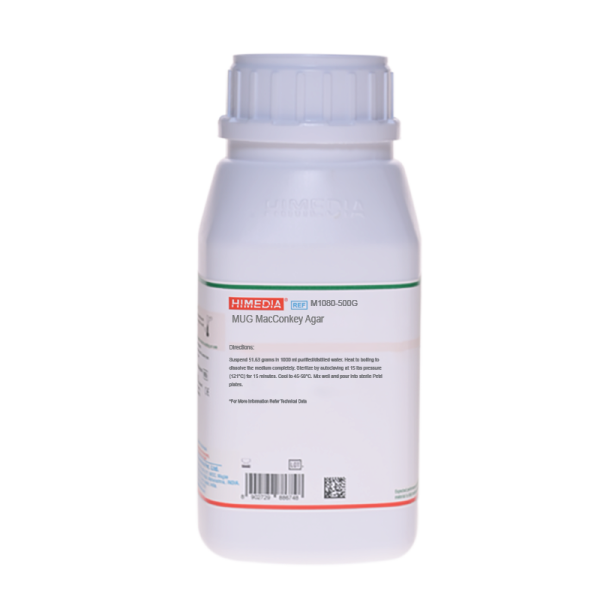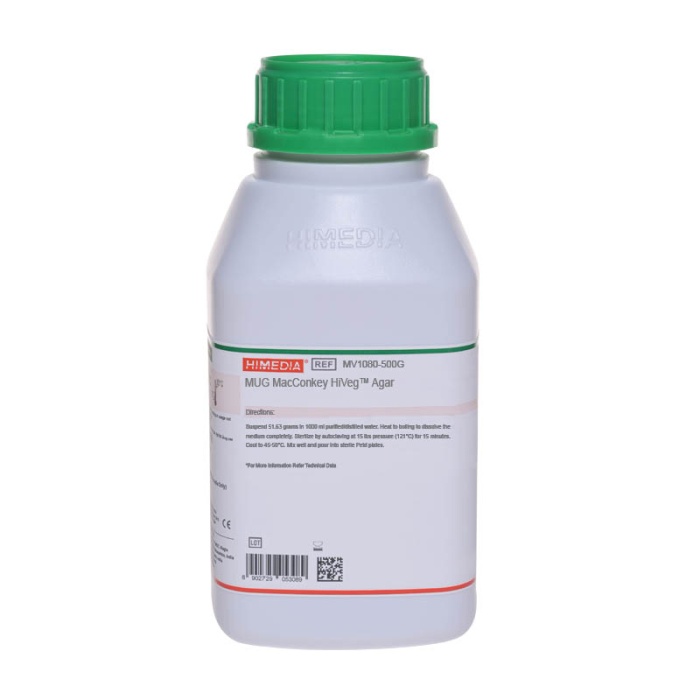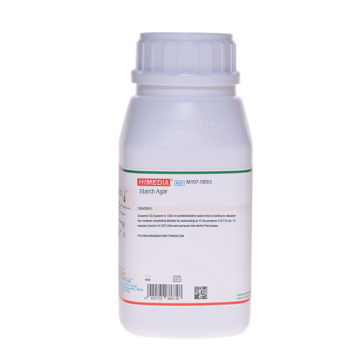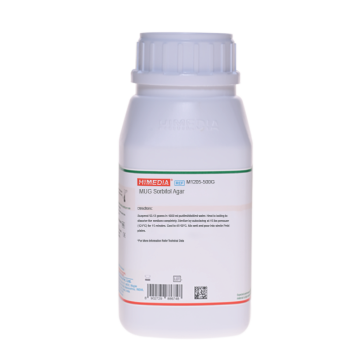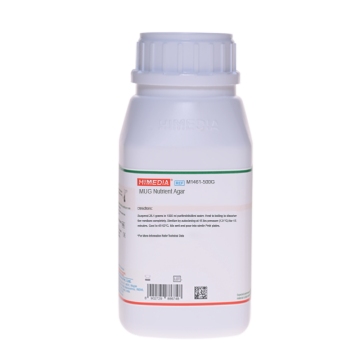 Your enquiry has been submitted
Your enquiry has been submitted
MUG MacConkey Agar
Coliforms - Isolation#CC293D
Intended Use:
Recommended for selective isolation and detection of lactose fermenting coliform organisms by a fluorogenic method.
Composition
| Ingredients | Gms / Litre |
|---|---|
| Peptone | 20.000 |
| Lactose | 10.000 |
| Bile salts mixture | 1.500 |
| Sodium chloride | 5.000 |
| Neutral red | 0.030 |
| Crystal violet | 0.001 |
| 4-Methylumbelliferyl ß-D-glucuronide (MUG) | 0.100 |
| Agar | 15.000 |
Final pH (at 25°C): 7.1±0.2
**Formula adjusted, standardized to suit performance parameters
Directions
Suspend 51.63 grams in 1000 ml purified/distilled water. Heat to boiling to dissolve the medium completely. Sterilize by autoclaving at 15 lbs pressure (121°C) for 15 minutes. Cool to 45-50°C. Mix well and pour into sterile Petri plates.
Principle And Interpretation
MacConkey Agar is employed for the cultivation of enteric bacteria and in differentiation of lactose fermenters and non-fermenters. The medium contains bile salts to inhibit non-intestinal bacteria and lactose with neutral red indicator to distinguish the lactose-fermenting coliforms from the lactose-non-fermenting Salmonella and dysentery groups (2). MUG MacConkey Agar is based on the modification of MacConkey medium as per Trepeta and Edberg (8). It is used for the selective isolation and detection of lactose fermenting coliform organisms by a fluorogenic procedure. MUG MacConkey Agar helps to detect the presence of an enzyme B-glucuronidase and thereby rapidly identifying Escherichia coli in mixed clinical specimens (6).
Peptone provides essential nitrogen compounds for the growth of coliforms. Lactose is the fermentable carbohydrates source. Bile salts and crystal violet inhibit the growth of gram-positive bacteria. Neutral red is the pH indicator. MUG is cleaved by the enzyme ß-glucuronidase to release an end product 4-methylumbelliferone which produces a visible greenish-blue fluorescence under long wave ultra-violet light (366nm). The medium can be directly inoculated with the test specimen by streaking.
Type of specimen
Clinical samples; Food and dairy samples; Water samples.
Specimen Collection and Handling
For clinical samples, follow appropriate techniques for sample collection and processing as per guidelines (4,5).
For food and dairy samples, follow appropriate techniques for sample collection and processing as per guidelines (7,9).
For water samples, follow appropriate techniques for sample collection and processing as per guidelines (1).
After use, contaminated materials must be sterilized by autoclaving before discarding.
Warning and Precautions:
In Vitro diagnostic use. Read the label before opening the container. Wear protective gloves/protective clothing/eye protection/face protection. Follow good microbiological lab practices while handling specimens and culture. Standard precautions as per established guidelines should be followed while handling specimens. Safety guidelines may be referred in individual safety data sheets.
Limitations
- Though the medium is recommended for selective isolation, further biochemical and serological testing must be carried out for further confirmation.
- The plates are exposed to ammonia fumes to increase fluorescence as suggested by Freir and Hartman (3).
- The surface of the medium should be dry when inoculated.
- Approximately 40% of Shigella spp. and various biotypes of Salmonella may also be ß-glucuronidase positive (3).
Performance and Evaluation
Performance of the medium is expected when used as per the direction on the label within the expiry period when stored at recommended temperature.
Quality Control
Appearance Light yellow to pink homogeneous free flowing powder
Gelling Firm, comparable with 1.5% Agar gel
Colour and Clarity of prepared medium Red with purple tinge clear to slightly opalescent gel forms in Petri plates
Reaction Reaction of 5.16% w/v aqueous solution at 25°C. pH: 7.1±0.2
pH 6.90-7.30
Cultural Response
Cultural characteristics observed after an incubation at 35 - 37°C for 18 - 24 hours.
| Organism | Inoculum (CFU) | Growth | Recovery | #Fluorescence under uv |
|---|---|---|---|---|
| Klebsiella aerogenes ATCC 13048 (00175*) | 50-100 | luxuriant | >=50% | negative |
| Escherichia coli ATCC 25922 (00013*) | 50-100 | luxuriant | >=50% | positive |
Key :(*) Corresponding WDCM numbers
Storage and Shelf Life
Store between 10- 30°C in a tightly closed container and the prepared medium at 20-30°C. For better performance of is advised to store the plates at 2-8°C. Use before expiry date on the label. On opening, product should be properly stored dry, after tightly capping the bottle in order to prevent lump formation due to the hygroscopic nature of the product. Improper storage of the product may lead to lump formation. Store in dry ventilated area protected from extremes of temperature and sources of ignition. Seal the container tightly after use. Product performance is best if used within stated expiry period.
Disposal
User must ensure safe disposal by autoclaving and/or incineration of used or unusable preparations of this product. Follow established laboratory procedures in disposing of infectious materials and material that comes into contact with clinical sample must be decontaminated and disposed of in accordance with current laboratory techniques (4,5).
Reference
- Baird R.B., Eaton A.D., and Rice E.W., (Eds.), 2015, Standard Methods for the Examination of Water and Wastewater, 23rd ed., APHA, Washington, D.C.
- Cruickshank R., Duguid J. P., Marmion B. P., Swain R. H. A., 1975, Medical Microbiology, Churchill Livingstone.
- Freir T. A. and Hartman P. A. (1987) Appl. Env. Microbiol. 53. 1246-1250.
- Isenberg, H.D. Clinical Microbiology Procedures Handbook 2nd Edition.
- Jorgensen, J.H., Pfaller, M.A., Carroll, K.C., Funke, G., Landry, M.L., Richter, S.S and Warnock., D.W. (2015) Manual of Clinical Microbiology, 11th Edition. Vol. 1.
- MacFaddin J. F., 1985, Media for Isolation-Cultivation-Identification Maintenance of Medical Bacteria, Vol. I, Williams and Wilkins, Baltimore.
- Salfinger Y., and Tortorello M.L., 2015, Compendium of Methods for the Microbiological Examination of Foods, 5th Ed., American Public Health Association, Washington, D.C.
- Trepeta R. W. and Edberg S. C., 1984, J. Clin. Microbiol., 19 (2) :172.
- Wehr H. M. and Frank J. H., 2004, Standard Methods for the Microbiological Examination of Dairy Products, 17th Ed., APHA Inc., Washington, D.C.
| Product Name | MUG MacConkey Agar |
|---|---|
| SKU | M1080 |
| Product Type | Regular |
| Physical Form | Powder |
| Origin | Animal |
| Packaging type | HDPE |
| References | 1. Cruickshank R., Duguid J. P., Marmion B. P., Swain R. H. A., 1975, Medical Microbiology, Churchill Livingstone |
| Customized Product Available | No |



